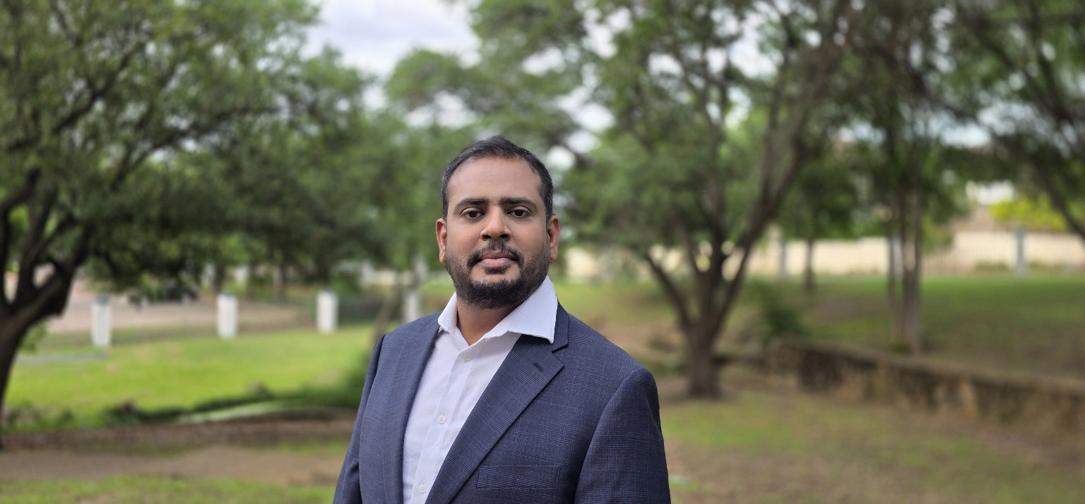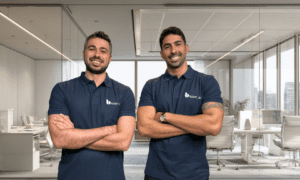As AI models of today’s accelerated digital transformation now power decision-making and quantum computing looms on the horizon, the stakes for cybersecurity have never been higher. In this insightful interview, Ankit Gupta, a Dallas-based cybersecurity and AI governance leader with over 14 years of experience, unpacks the evolving challenges and opportunities at the intersection of cloud security, AI ethics, and post-quantum resilience. From building cloud-native architectures that can withstand chaos, to pioneering responsible AI governance and preparing for quantum-era cryptographic disruption, Ankit offers a strategic and hands-on perspective rooted in deep technical expertise and industry foresight. As the founder of the SecureAzCloud blog and a recognized voice in global security circles, he emphasizes that cybersecurity today is no longer just about protection, it’s about enabling innovation safely, responsibly, and at scale.
Please tell us more about yourself.
I’m Ankit Gupta, a cybersecurity and AI governance professional based in Dallas, Texas. With over 14 years of experience designing security programs that protect some of our economy’s most critical sectors, finance. I specialize in architecting secure cloud-native environments, developing AI governance frameworks, and aligning cybersecurity with business outcomes in complex, high-stakes environments.
My career has centered around a core challenge: how to secure systems that are too complex to pause, too interconnected to isolate, and too vital to fail. I lead efforts around enterprise cloud security architecture and responsible AI integration , ensuring compliance, resiliency, and long-term risk mitigation.
Beyond my organizational role, I actively contribute to the broader cybersecurity ecosystem. I publish practical guidance through my blog, SecureAzCloud, and contribute hands-on tools and scripts to support security teams worldwide. I also serve as a content developer for industry certifications, judge for global cybersecurity awards, and peer reviewer for technical publications, reflecting my recognition as a subject matter expert.
My work is rooted in the belief that cybersecurity isn’t just a technical discipline, it’s a strategic imperative for national resilience and innovation. Whether mentoring new talent, developing frameworks adopted at scale, or supporting regulatory alignment through AI governance, I remain focused on contributing to a safer, brighter, and more secure digital future for my organization, the industry, and the nation.
Can you walk us through your journey into cybersecurity and AI, and what motivated you to focus specifically on advancing cloud security and AI governance?
Like many in cybersecurity, my journey started with curiosity, the drive to understand how systems break and, more importantly, how they should be built to withstand evolving threats. Early on, I realized I wasn’t content just running security tools; I wanted to architect secure systems from the ground up. That passion led me to lead cloud transformation initiatives across highly regulated environments, where I designed resilient architectures aligned with Zero Trust and NIST 800-53 frameworks.
I saw a massive opportunity and a widening risk gap when cloud computing became mainstream. Enterprises were adopting cloud technologies rapidly, but security was too often reactive or bolted on. That’s when I committed myself to cloud security architecture as a discipline, helping organizations embed security by design, scale confidently, and meet the growing demands of compliance and sovereignty.
In parallel, my interest in AI evolved from technical exploration to strategic governance. As AI began influencing decisions, automation, and even cyberattacks, it became clear that new security models were needed. I’ve since worked on developing AI governance frameworks, contributed to industry panels on responsible AI, and published insights on protecting AI pipelines against adversarial threats. I aim to ensure we don’t compromise trust, privacy, or accountability as we accelerate innovation.
Today, my work sits at the intersection of cloud security, AI governance, and regulatory resilience , increasingly vital to the U.S. national interest. Whether it’s securing healthcare data, financial infrastructure, or public sector workloads, I believe cybersecurity must now extend beyond defense; it must enable transformation. That belief continues to drive my contributions to the field , through architecture, advocacy and thought leadership.
Your work emphasizes developing secure cloud architectures. What key strategies or frameworks do you believe are essential for building truly resilient cloud environments today?
Resilience in the cloud isn’t just about keeping the lights on , it’s about making sure the lights don’t flicker when someone tries to break in, reroute the power, or file a lawsuit over how bright they are. When I design cloud security architectures, I don’t just ask, “Is it secure?” , I ask, “Can this thing survive chaos without waking someone up at 3 a.m.?”
My approach leans heavily on adaptive design: security that isn’t bolted on but baked in. That means starting with identity and data flows , who’s accessing what, why, and how often , and building systems that assume things will go wrong. Misconfigurations happen. Tokens leak. Someone forgets a dev environment running in the wild. Good architecture doesn’t just detect these; it contains them before they become tomorrow’s headline.
I follow a principle I call “trust, but verify, continuously and with receipts.” Every access, every permission, and every data movement should be contextual and traceable. However, frameworks and policies are only half the story. Real resilience comes from what I call security reflexes, systems that sense trouble and respond automatically, not just alert and wait.
Over the years, I’ve helped build architectures that don’t crumble when one layer fails , they adapt, reroute, and recover. That’s not just smart design , it’s necessary when protecting environments that support healthcare data, financial transactions, and national infrastructure. And let’s be honest , if your cloud can’t handle a minor permissions slip without spiraling, it’s not resilient. It’s just lucky.
I believe we’ve moved beyond designing for uptime. Now, we’re designing for unknown unknowns, and that’s where the real challenge (and satisfaction) lies. In short, your cloud environment is not truly resilient if it can’t survive a permissions misconfiguration or a rogue API call at 3 a.m. without major fallout. I design systems to expect failure, isolate impact, and recover fast, that’s the new definition of cloud security maturity.
You’ve been actively strengthening data protection frameworks. In your view, how should organizations rethink their data security models in the era of AI-driven threats and increasing cloud adoption?
Traditional data security was built for a world that no longer exists, one where data sat neatly inside a corporate firewall, users logged in from offices, and threats came with a return address. Fast-forward to today and data is everywhere: scattered across cloud services, embedded in third-party APIs, copied to personal devices, and increasingly absorbed into AI models where it can be extracted in ways we’re still discovering.
In this new reality, we can’t protect what we can’t see , and we definitely can’t secure data with yesterday’s playbook. My approach to data security is simple in theory but rigorous in practice: move from protecting perimeters to protecting the data itself. That means knowing where it lives, how it moves, who touches it, and why , whether it’s sitting idle or being fed into a machine-learning pipeline at 2 a.m.
But AI doesn’t just amplify the opportunity; it rewrites the risk model. We now face entirely new threat vectors: model inversion attacks, sensitive data leaking through prompts, and even biased outcomes due to tainted training sets. So, I build data protection frameworks that don’t just ask, “Is this secure?” but “Is this ethical, explainable, and accountable?” Governance can’t be an afterthought in the AI era , it has to be native to how data is collected, labeled, and consumed.
In my view, the future of data protection isn’t about saying “no.” It’s about knowing enough to say “yes , with conditions.” Policies must follow data wherever it goes, adapt to context, and act automatically , not based on static rules but on real-time risk.
We’re long past the age of locking down information and hoping for the best. Today, data security must operate like a living system: sensing, adapting, and learning , just like the threats it defends against. But that’s only half the story. AI introduces new risks like data leakage through model inference, unintentional exposure via LLM prompts, and bias in data training sets. My approach includes aligning data governance with responsible AI principles , ensuring that the data used to train, test, and infer is secure, ethical, and traceable.
Responsible AI practices are a significant theme in your professional focus. How do you see AI governance evolving in cybersecurity over the next five years?
Most AI governance efforts are like first drafts , well-intentioned, messy, and clearly written under deadline pressure. We’re still figuring out what responsible AI means in a world where machine learning quietly makes decisions that affect hiring, lending, diagnostics, and national security posture.
Over the next five years, AI governance won’t just be about bias audits and model fairness. It will become a central pillar of enterprise risk management, as critical as identity governance or data classification is today. We’re moving into an era where organizations must prove that their AI works, how it works, why it behaves the way it does, and who is accountable when it doesn’t.
I expect cybersecurity and AI governance to merge , fast. Threat actors already leverage generative AI to automate phishing, bypass filters, and poison decision models. That means we’ll need to protect AI systems and govern their use with the same discipline we apply to privileged infrastructure. Think: access controls, audit logs, human-in-the-loop review, and yes, a healthy level of skepticism.
In my work, I’ve developed internal governance layers beyond compliance checklists. I focus on building trustworthy AI ecosystems , with input validation, model traceability, and decision accountability baked in from design to deployment. I treat AI as a high-risk asset, not a shiny tool, and that mindset shift is what more organizations will need to embrace.
At its core, responsible AI isn’t just about managing risk, it’s about preserving trust. And that can’t be outsourced. Cybersecurity, legal, and data science all must co-own the outcomes. If we get this right, AI becomes an enabler of resilience. If we don’t, it becomes a liability that scales faster than we can respond.
Post-quantum cryptography is becoming an urgent topic. From your perspective, how should organizations start preparing for the cybersecurity challenges that quantum computing will introduce?
I like to use this phrase: “Crypto-agility is the new resilience.” Quantum computing won’t break the internet overnight, but it will render many widely used encryption algorithms obsolete , and we won’t get much warning when that moment arrives.
Organizations should first discover where and how cryptographic algorithms are used across systems, APIs, embedded devices, and third-party platforms. Most enterprises don’t have a complete inventory of their cryptographic dependencies, which makes transition planning difficult.
The second is readiness. That means moving away from static crypto libraries and designing infrastructure that supports modular or pluggable cryptography. You’re already behind if you can’t rotate keys or swap algorithms without a full re-architecture.
Third, and I stress this in executive conversations, we must start aligning with NIST’s post-quantum cryptography (PQC) standardization process now. Organizations that wait until PQC becomes mandatory will find themselves playing expensive catch-up.
We must start designing encryption strategies that anticipate quantum-resistant curves and future-compatible libraries. This also means secure onboarding frameworks for vendors are beginning to include language around crypto agility and long-term key safety.
Quantum is not just a technology problem , it’s a policy and architecture challenge. We can’t afford to treat it like science fiction when the risks of decryption are very real and potentially retroactive.
Could you share some insights from your SecureAzCloud blog; particularly how sharing scripts, tutorials, and best practices with the community has helped foster stronger cybersecurity knowledge across industries?
SecureAzCloud began as a personal project, a space to document my experiences and solutions in cloud security. Over time, it evolved into a platform where I share scripts, tutorials, and insights to demystify complex cybersecurity concepts.
The blog has also served as a collaborative hub, exchanging ideas and refining best practices. By fostering an environment of open knowledge sharing, we’ve collectively advanced our understanding and implementation of effective cybersecurity measures.
Moreover, articulating and sharing these insights has deepened my understanding. Teaching others forces you to clarify your thoughts and anticipate questions, leading to a more robust grasp of the subject matter.
I see SecureAzCloud as part of a broader responsibility. In a field where information is often scattered, paywalled, or overly academic, I want to be the person who makes security practical without compromising on quality or ethics. Judging by the traction, I think it’s making a difference.
In essence, SecureAzCloud has become more than just a blog; it’s a conduit for continuous learning and community building in the ever-evolving field of cybersecurity.
How do you blend your cloud security, AI governance, risk management, and cybersecurity leadership expertise into your day-to-day decision-making , especially in cross-functional environments?
Cybersecurity today isn’t one discipline , it’s a conversation between many. Cloud transformation, AI integration, regulatory expectations, and real-time threats don’t arrive in silos, neither should our response.
My certifications, spanning cloud security, privacy, risk, and AI governance, give me a structured lens through which to view complex challenges. But in practice, they serve as guiding compasses, not checklists. When building controls, advising stakeholders, or reviewing architectures, I constantly toggle between the technical, strategic, and ethical.
For example, cloud expertise helps me shape resilient and future-proof infrastructure. Risk management lets me spot blind spots before they turn into breach reports. And AI governance? It’s increasingly about ensuring our smart systems don’t make dumb decisions, whether it’s protecting sensitive data, flagging bias, or ensuring transparency in automated processes.
But leadership is what ties it all together. I’ve learned that translating risk into business terms is often more potent than deploying another tool. It’s about giving teams clarity, not just controls. Whether working with engineers, legal teams, or compliance, my role is often that of a translator , turning regulatory requirements into secure workflows or turning an abstract risk into something tangible and solvable.
Multidisciplinary work isn’t a luxury in security anymore , it’s the baseline. My job is to ensure that security doesn’t slow the business down but actually enables it to move faster, smarter, and more confidently.
You’re currently researching how AI and quantum cryptography intersect with cloud security , and you’ll be presenting your insights at an upcoming IEEE Cloud Security Summit. What key trends are you focusing on, and how should organizations prepare for the disruption these technologies bring?
This research , and the upcoming IEEE Cloud Security Summit, where I’ll be presenting , is my effort to help the security community think two steps ahead. We’re entering an era where AI redefines how attacks are crafted, and quantum computing threatens to break the encryption standards we’ve relied on for decades. That’s not a sci-fi headline , it’s a near-term reality.
My work focuses on helping both technical teams and executive stakeholders make sense of this collision. I’m exploring defenses against model manipulation, inference abuse, and autonomous decision poisoning on the AI front , all of which can silently erode trust and control in cloud-native systems. On the quantum side, I’m advocating crypto-agility , designing infrastructures that can adapt to post-quantum algorithms without reengineering everything from scratch.
But there’s a broader theme here: security isn’t just about building higher walls anymore, it’s about building systems that can pivot, adapt, and recover as the ground shifts underneath them. Whether AI, quantum, or the next unknown, organizations need layered, identity-aware, context-driven controls, not hardcoded assumptions that don’t survive innovation.
I make this case simple for business leaders: AI and quantum are not future problems, they’re risks with delayed consequences. If cybersecurity doesn’t evolve in sync, we’ll find ourselves reacting to crises instead of building resilience.
I see this research and presentation as a way to raise awareness and help shape the strategies governments, enterprises, and regulators must adopt. We’re not just securing systems anymore, we’re ensuring the future’s trust in technology.
In a rapidly shifting threat environment, what advice would you give to emerging cybersecurity professionals who want to specialize in cloud security and AI governance, areas where you have established considerable expertise?
My biggest advice? Get uncomfortable early , and often. The most successful cybersecurity professionals I’ve mentored didn’t start with a wall full of certifications. They began by asking better questions, stepping into the unknown, and turning learning into a lifestyle, not a checkbox.
If you’re leaning toward cloud security, go beyond reading whitepapers. Build something real, break it, secure it, and repeat. You’ll learn more from one insecure VM than from ten sanitized tutorials. The cloud isn’t about mastering tools , it’s about understanding systems, flows, and risks in motion.
For AI governance, remember: it’s not just a technical puzzle. It’s an ethical, operational, and human one. Understanding model bias is essential , but so is asking who’s impacted, what data’s being used, and how decisions are explained. That means you can’t work in a silo. Collaborate with data scientists, legal teams, and policy thinkers. Some of the best security insights come from outside the security team.
Also, build your voice. Whether it’s a GitHub repo, a blog post, or a short talk, share what you’re learning and how you think. In a world full of noise, clarity is rare and valuable. Employers , and the field , pay attention to people who make things understandable and actionable.
Finally, don’t chase shiny tech for its own sake. AI and quantum may headline the future, but your value lies in making those technologies trustworthy. If you can help an organization innovate safely, you’re not just building a career but shaping how the future gets secured.
Mentoring emerging professionals and publishing practical resources for them is part of my long-term contribution to strengthening the cybersecurity talent pipeline. We need more curious, critical, and courageous people, and I support them however possible.



































